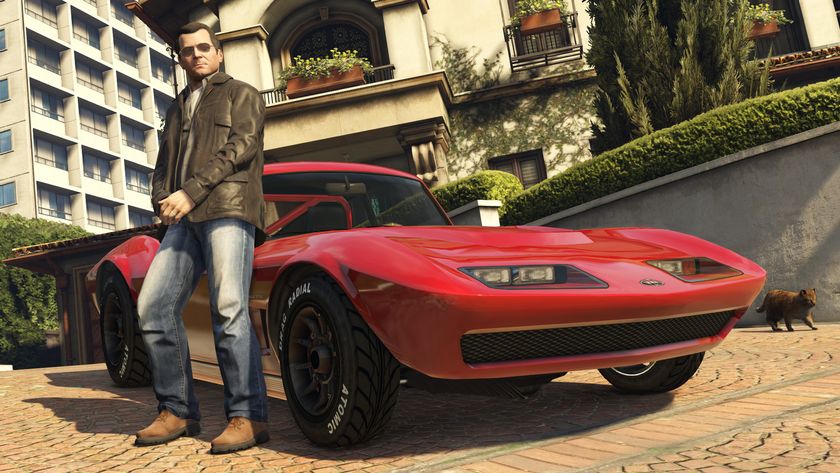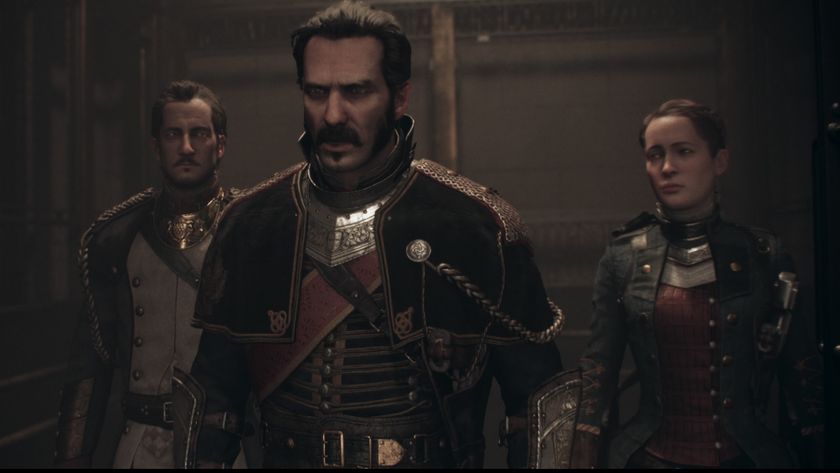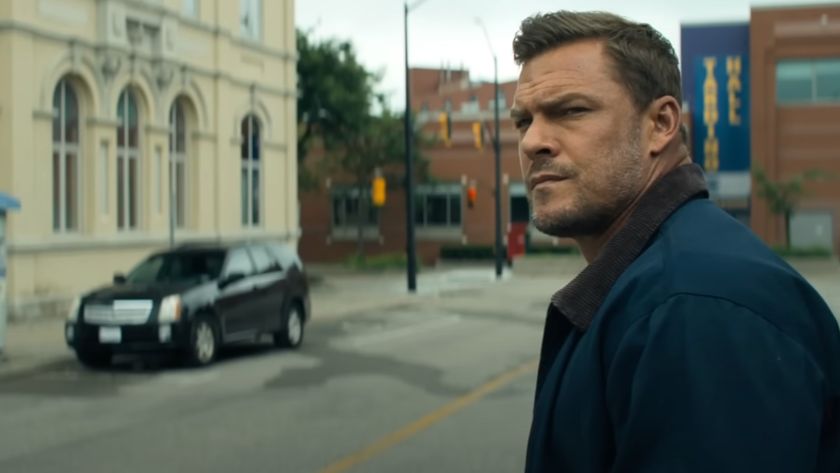How the new Wolfenstein is more than just shooting Nazi Robots
Wolfenstein: The New Order is not a game about shooting Nazi robots. Of course, on the surface of it, the above statement is nonsense. You’ll be shooting a lot of the mechanised Reich during the course this year’s sequel. A Hell of a lot. So many, in fact, that by the end of it all PETA will probably have started a campaign for their protection. But underneath the expected--and entirely welcome--return of Wolfie’s hectic, breakneck brand of jubilant fascist-smashing, there’s something more going on.
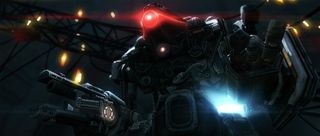
I noticed it during my most recent hands-on last month. During the game’s opening sections, set amid a last-ditch, desperate assault on a coastal Nazi stronghold during the game’s extended, alternate World War II, I felt an unmistakable inkling that something smarter was afoot. When I fired the game up, I had certain hopes and expectations. Flagrant carnage. Guns the size of caravans. Free-flowing, high-speed, tactical combat. The dual-wielding of everything. The New Order delivered all of these and more, but it also gave me something that I wasn’t expecting in the slightest. Real, affecting human drama, with a great deal of pathos. For all the crazy, explosive, sci-fi excess on display, The New Order is a game grounded in a powerful, sometimes even upsetting sense of reality.
You see this new Wolfenstein isn’t taking the easy, obvious approach. It could well have simply imparted a roaring rampage of retro revenge, and no-one would have batted an eyelid. But The New Order is being made by MachineGames, a new developer, but one with a long-standing pedigree in creating believable, resonating worlds through its inclusion of ex-Starbreeze staff responsible for the likes of The Darkness and the Chronicles of Riddick games.
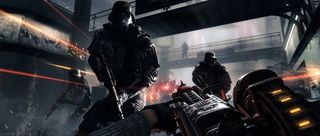
“I feel like it’s a culmination of our journey in this industry, learning how to convey that kind of characterisation in a video game.”, says Creative Director Jens Matties. “Obviously there are video games where story is everything; it’s an interactive movie essentially. And there are video games where story is nothing; it’s all about the gameplay and the story is [just] there because you have to be in a setting and somebody has to tell you what to do. Our aim has always been to integrate and merge those two components in the best possible way. We’ve got better at it over the years, and so with each game we do, the more lessons we learn and the better we get at making these digital heaps of polygons feel like humans”.
But even for a studio dedicated to narrative quality in action gaming, applying that philosophy to a new Wolfenstein is surely one heck of a challenge to set. After all, this is a series with its roots firmly in the comic-book schlock of FPS’ earliest days, when gore, carnage, and cartoon mecha-Hitlers were the genre’s raison d’etre. Transplanting that quintessential Wolfenstein vibe into a sophisticated, modern narrative environment is a highly impressive trick to pull off.
“It’s really important to us that not only do we honour the legacy, but also that we put something fresh out there too”, Matties tells me. “And we try to do that on all fronts. So one of them is on the gameplay front; it feels old-school and familiar, but it also feels modern and new. And one of them is in the story, taking these old-school concepts and making them interesting, looking at the depths beneath all of that.”
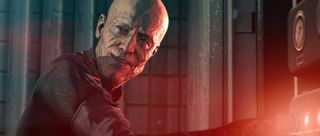
Those depths are apparent from The New Order’s opening moments. Even during the game’s frantic opening sequence, in which stalwart hero BJ Blazkowicz and a long-standing war buddy struggle to keep their plane aloft before plunging into the salty Hell of a furious beach assault, the most immediately striking elements are not the advanced Nazi fighter planes or the jaw-mashing robot dogs, but the underplayed warmth and humanity underpinning the dialogue and dynamic between the two comrades. The New Order might not be gunning for realism, but it understands that believability isn’t about plausibility. It’s about having convincing characters behave like real people in real situations. Use that as your in-road to empathy, and you can ground any level of madness in a pervading sense of truth.
Sign up to the 12DOVE Newsletter
Weekly digests, tales from the communities you love, and more
Wolfenstein nails that from the off. Even when perforating Nazi after Nazi with duel-wielded assault rifles, the welfare of Blazko’s put-upon squad is always on my mind. When we become locked in a fiery, room-sized deathtrap, and are then forced to fight for our lives against an experimental monstrosity sporting steampunk power-armour, the sense of real fear for real human lives elevates the set-piece far beyond the surface thrill of its action-movie tropes. After that, The New Order forces me into an agonising, lose-lose moral decision. Given how attached I now am to the game’s world and characters following all of the above, the moment ruins me in a way I haven’t experienced since Telltale’s The Walking Dead.

But all of this is just an hors d’oeuvre for Wolfenstein’s real, jack-booted kick in the teeth. As the mission goes south, Blazkowicz receives a head injury, garnished with a free side-order of coma. It’s a long coma. He wakes up in a rural mental asylum, long after the Nazis’ victory in the war has lead to their total domination of the globe. This is where Wolfenstein: The New Order really starts. And after enticing players with the familiar bang of its prologue, it reveals that a pained whimper was its real intent all along. Narrative Designer Tommy Tordsson confirms this when I put the point to him:
“The prologue is where we establish where the franchise has been in the past, and when that moment happens, where your character is put in a coma, there’s where we diverge from where we used to be and go into this completely unexplored territory.”
That unexplored territory refers not just to The New Order’s new world--an alternative 1960s, “uniform, drained of life, and almost culturally incestuous”--but to what amounts to a full deconstruction of the gung-ho themes and archetypes of the old-school shooter. This is the same Blazkowicz we’ve known before; MachineGames certainly isn’t sweeping away his legacy. Rather, it’s leveraging the one-man-army’s storied history maturely and analytically, to turn iD Software’s lantern-jawed bullet-sponge into a real man for the first time.
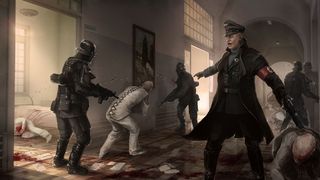
Explains Matties:
“The original inception of BJ Blazkowicz is this muscle-bound action-hero, and so you’re faced with this choice: Either we stray away from that and make our own version that is radically different--sort of a Nathan Drake-type character or whatever--or we honour it and we try to see what the world would be like for this kind of character. And we really wanted to honour the legacy of Wolfenstein 3D, so that’s what we chose. I think in retrospect that has been a very good choice and we’re really happy about how that character came out; taking an archetypal character like that and turning him into an interesting person.”
Tordsson elaborates:
“The way we approached BJ was to really look at how he’s gone through all these games. He’s gone through a lot of battles and fighting, and really what we found interesting to explore was this aspect of him being really combat-weary, of being tired and sick of always fighting. And having him dream of having the quiet, normal life in the countryside with a family.”
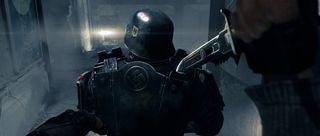
Blazko comes painfully, ironically close to that dream following his escape from the asylum. In a disarmingly subtle subversion of the traditional video game ‘big reveal’, his comprehension of this dark new world comes not from striking blunt imagery, but a downplayed, saddening conversation with a broken-down elderly couple on an equally broken-down farm. Again, humanity, not pomp and explosions, becomes the path to drama. As Tordsson explains:
“That is part of grounding it in humanity. You can choose to open up with seeing the Statue of Liberty crumble, but to us it’s more important to see what has happened to normal people in this world; how have they been affected by the Nazis taking over the world?”
The scene is a startlingly powerful one, pulling the rug out from under player and protagonist alike. Where many games would deliver a quick exposition-dump before returning to the earlier carnage with a new excuse for the slaughter, The New Order instead pulls apart everything Blazkowicz has previously represented. There is no immediate fight to be had, because the fight has gone out of the world. He can’t take charge of a resistance movement, because the populace has long-since accepted the path of least resistance as the only way to survive.
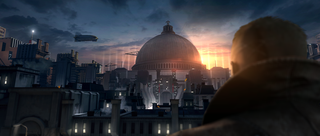
He doesn’t end the scene with a gun in his hand and renewed vigour in his heart, but with a heavy sense of sheer, disempowered frustration, isolated and standing for nothing but his own, now-anachronistic sense of will. The steady drip-feed of cultural degradation is a favoured tool of the fascist, and here it seems to be as powerful as any of the super-charged firepower on offer. Matties tells me that the team has been careful to ensure that its treatment of Nazi rule is thematically sound. And of course, it’s no coincidence that all of this is taking place in the ‘60s, one of the real world’s most politically charged decades to date:
“…the horrible thing about the Nazis, it goes beyond just the war crimes and the sheer brutality of it. It’s also the psychological component of it, which is that it’s essentially strangling cultural expression as we know it. And what better decade to show that than the ‘60s, where this cultural rebellion occurred? What would have happened if all of that had just been sanitised and neutered, and they’d taken the whole soul out of that cultural movement?”
Tordsson agrees, as we reflect upon how much video games’ treatment of real-world conflict has changed since Wolfenstein 3D. The sombre reverence of the modern military shooter is a far cry from the days of chainguns and mutant rats. Though we have kept the Nazi zombies.
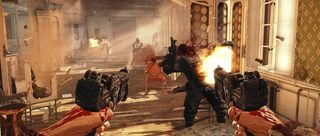
“Obviously there are the massive atrocities that occurred during World War II, and we didn’t want to make light of that. In other words, what we felt was important to us was to show the brutality of the opposition, not only in terms of violence but in terms of ideology, in a way that felt authentic…. So you will have an experience that is completely outlandish sometimes, where people perform larger-than-life heroics and things are supremely over the top, but it’s rooted in themes that feel real and feel authentic.”
The nuance of Nazi rule goes through to individual characterisation. It’s ironic, though perhaps understandable, that the most evil regime in human history has been turned cartoonish in so much fiction since, but even in a game like Wolfenstein such archetypes need not be a crutch.
“Nazi characters have been portrayed a lot in movies”, says Tordsson. “It’s hard to diverge from that image that people have of them from stories and books and movies. But it’s a philosophy we have here at MachineGames that you always need to have a sense of characters being real people, even if they’re villains. So we try to create backstories for them where you can discern some kind of reason why they’ve become these monsters. That’s something that I believe subconsciously affects you when you write these scenes and dialogues for them, if you have these backstories created beforehand.”
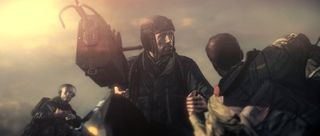
The results of MachineGames’ efforts ring loud and clear through what I’ve so far experienced of Wolfenstein: The New Order, sounding an unmistakably human voice above the explosive din and crumpling of metal. And lest we forget, said giddy carnage is rather excellent in its own right. Should everything come together as hoped, we just might be looking at the first surprise hit of 2014. At the very least, it promises to be one of the most interesting franchise reworks we’ve seen in quite some time.
Most Popular






